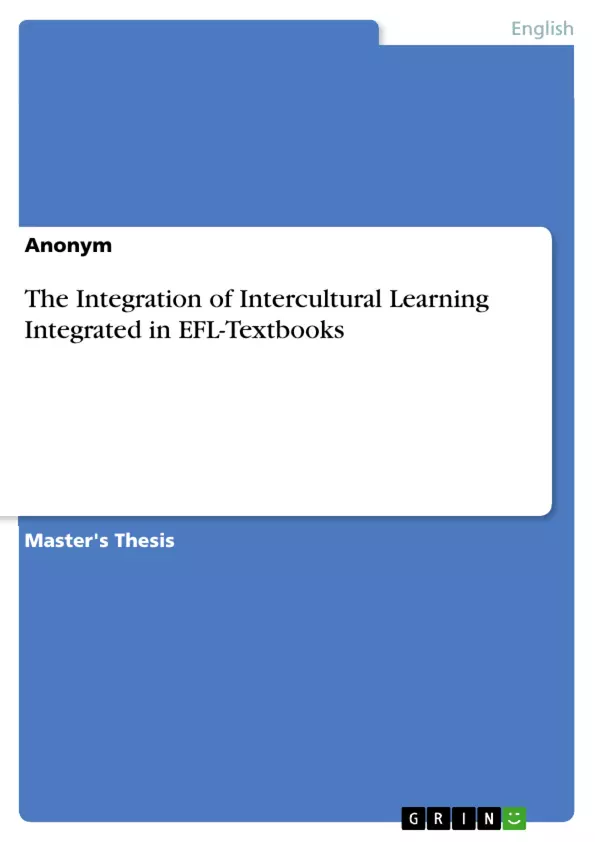This paper will be evaluating a unit of the textbook Greenline Oberstufe in order to determine whether transcultural and intercultural communicative competences are fostered by the textbook. To do so, this paper will first look at intercultural learning in general and how this concept takes shape in the Common European Framework of References for Languages and in the Curriculum of North Rhine Westphalia. The didactic principal of Byram’s modified model of transcultural and intercultural communicative competences will then be elaborated.
Based on this, criteria for the analysis will be determined. The analysis of the textbook unit will be divided into three parts, where first culturally relevant tasks will be identified and described. Secondly, the unit will be analysed according to the five components of the model of transcultural and intercultural communicative competences. Ultimately it will be determined whether the textbook unit fulfilled the objectives of the five components of transcultural and intercultural communicative competences.
Inhaltsverzeichnis (Table of Contents)
- Introduction
- Intercultural Learning
- Culture and Identity
- Interculturalism
- Components of Intercultural Competences
- The Common European Framework of Reference for Languages
- North Rhine Westphalia's Curriculum for Gymnasium and Gesamtschule
- Intercultural Learning in the EFL-Classroom
- Intercultural Competences in the Foreign Language Classroom
- New Purposes for language learning
- Transculturality
- Didactic Principles
- Byram's Model of Intercultural Communicative Competence
- Knowledge
- Skills of Interpreting and Relating
- Skills of Discovery and Interaction
- Attitude
- Critical Cultural Awareness
- Model of Inter-/ Transcultural Communicative Competences
- Byram's Model of Intercultural Communicative Competence
- Method and Material
- Reflection on Textbook Analysis
- Criteria for Analysing Intercultural Competences in Textbooks
- Level of Objective Description
- Level of Subjective Analysis
- Level of Subjective Inference
- Presentation of the Textbook 'Greenline'
- Evaluation of the Textbook Unit India
- Level of Objective Description
- Level of Subjective Analysis
- Knowledge
- Attitudes
- Skills of Interpreting and Relating
- Skills of Discovery and Interaction
- Critical Cultural Awareness
- Level of Subjective Inference
Zielsetzung und Themenschwerpunkte (Objectives and Key Themes)
This master's thesis explores the integration of intercultural learning within English as a Foreign Language (EFL) textbooks. The paper aims to investigate whether a specific textbook unit effectively fosters the development of transcultural and intercultural communicative competences in learners. By examining a unit from the textbook "Greenline Oberstufe," the study analyzes how the textbook integrates intercultural learning principles and concepts into its content and activities.
- Intercultural Learning in EFL Education
- Textbook Analysis and Intercultural Competence Development
- The Role of Transcultural and Intercultural Communicative Competences
- Byram's Model of Intercultural Communicative Competence
- Evaluation of Textbook Unit Content and Activities
Zusammenfassung der Kapitel (Chapter Summaries)
The introductory chapter provides a background on the importance of intercultural learning in a globalized world, highlighting the role of education in promoting peaceful coexistence and understanding. It also introduces the concept of intercultural competences, emphasizing their significance in navigating cultural diversity and fostering inclusive societies. The chapter concludes by emphasizing the importance of integrating intercultural learning into EFL textbooks and outlining the rationale for the current study.
Chapter 2 delves deeper into the concept of intercultural learning, examining the relationship between culture and identity, exploring the significance of interculturalism, and defining the components of intercultural competences. The chapter further discusses the integration of intercultural learning into the Common European Framework of Reference for Languages (CEFR), highlighting its relevance to language learning across various contexts.
Chapter 3 focuses on the specific application of intercultural learning within the EFL classroom. It discusses the crucial role of intercultural competences in language learning and explores the shift towards new purposes for language learning in a globalized world. The chapter also examines the concept of transculturality and its relevance to intercultural learning.
Chapter 4 presents the theoretical framework of the study, exploring Byram's model of intercultural communicative competence in detail. The chapter elaborates on each component of Byram's model, including knowledge, skills of interpreting and relating, skills of discovery and interaction, attitude, and critical cultural awareness. The chapter further analyzes the implications of this model for textbook analysis and evaluation.
Chapter 5 delves into the methodology employed in the study. It outlines the criteria for analyzing intercultural competences in textbooks, focusing on the levels of objective description, subjective analysis, and subjective inference. The chapter concludes by presenting the specific textbook unit under investigation, "India," from the textbook "Greenline Oberstufe."
Schlüsselwörter (Keywords)
This master's thesis focuses on intercultural learning in English as a Foreign Language (EFL) textbooks, particularly exploring the integration of transcultural and intercultural communicative competences. The study utilizes Byram's model of intercultural communicative competence as a framework for evaluating a specific textbook unit. Key keywords include intercultural learning, intercultural competence, transculturality, textbook analysis, EFL education, and Byram's model.
- Quote paper
- Anonym (Author), 2022, The Integration of Intercultural Learning Integrated in EFL-Textbooks, Munich, GRIN Verlag, https://www.grin.com/document/1270489



